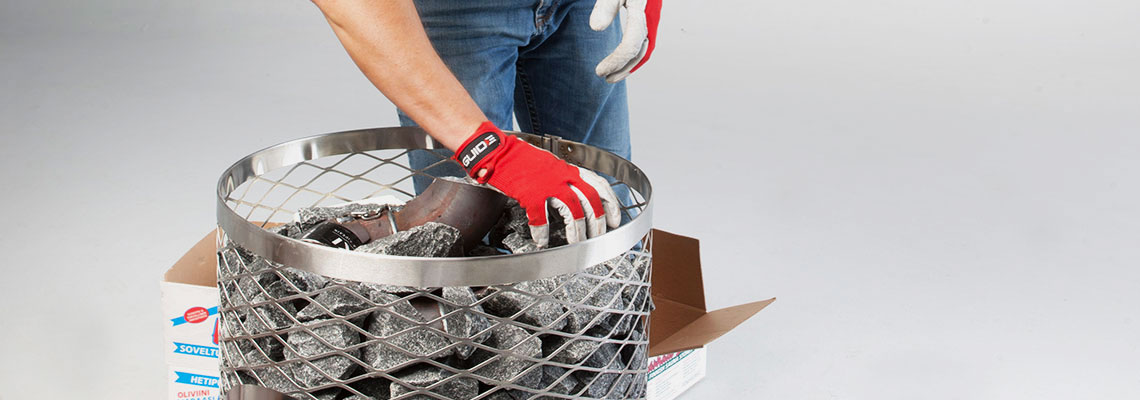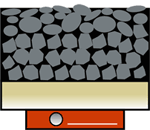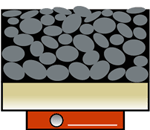
Electric sauna heaters
Install the sauna stones sparsely around the sauna heater regulators. Too tight installation can cause regulator overheating, and slow down the sauna heating process. For sparse composition the easy way is to use bigger sauna stones in the bottom, and smaller stones on the top. Top layer is sufficiently finished when the sauna stones cover the regulators.
Please check the correct positioning of the heater thermostat – not to be set on too high. After a couple of sauna baths the correct positioning can be determined and set easily.
Wood burning sauna stoves
Install the sauna stones sparsely into the stove. Bigger stones are selected to the bottom, and smaller stones to the top. The stones are laid into a slight slope. By using sparse installation of the stones the sauna heats up faster, and the sauna bath experience feels great.
Method 1

Install traditional sauna stones to the bottom of the sauna heater, and to the top ca. 1/3 of rounded sauna stones. The pouring water runs down through the rounded sleek stones into lower level stones generating greater vapor surface.
Method 2

Fill in the entire heater chamber with rounded sauna stones. This way the pouring water touches all the stones, generating extra soft steam. The stone capacity of the heater needs to be 20 kg in minimum, to prevent the pouring water to run through the stones too fast.
Correct warm-up procedure leads to better enjoyment
Rich steam and mild sauna bath enjoyment can be acquired by setting up/adjusting the heater thermostat. If it is set on too high the oxygen level inside the sauna decreases and the air temperature rises too high, resulting to uncomfortably dry and high temperature.
Rundown sauna stones, that have lost most their heat preservation and heat conductivity abilities, result to longer warm-up time, too dry inside air and can also shorten the heater lifetime.
The amount of sauna stones has a meaningful relevance to the soft steam also. In electric sauna heaters you may try to add up some more stones into the top layer to form a larger vapor surface. Ensure the sufficient airflow to prevent the regulators from overheating.
When using sauna stones that possess good heat preservation and conductivity characteristics, like the olivinediabase, an enjoyable bath experience can be obtained already on relatively low sauna temperature, thus saving energy. This also prolongs the heater lifetime and donates mild, soft steam.
Olivine diabase stone from the Satakunta region, Finland
The Satakunta olivinediabase is the youngest stone type of the precambrian bedrock in southern Finland, dating back only 1250-1270 million years. Olivinediabase stone can be found in particularly in the sandstone and rapakivi (a form of granite) areas in Finland. Diabase stone can be detected in long, narrow veins and in extensive multi-layer veins. These multi-layer veins can be 40 to 80 meters thick. Distinctive to olivinediabase is that its long placioclase splinters are crystallized, while crisscrossed dark minerals fill its empty spaces. This crossed structure, often detectable also by plain eyes, but especially clear in microscopic view, makes the stone exceptionally durable.
The undetoriated surface of the stone is grey, medium granulated, and of very steady quality. The main minerals of the stone are placioclase, and olivine. It contains also pyroxene, biotite, apatite, carbonate and ore minerals. The amount of sulphite minerals is so diminutive that no sulphur is released. It contains no asbestos. Based on its structure and composition, olivinediabase is an excellent choice for sauna stone.
The Satakunta olivinediabase as a sauna stone
Olivinediabase is an excellent choice for a sauna stone: - great nominal weight – good resistance for extreme temperature changes – excellent thermal capacity – good thermal conductivity – contains no harmful substancies
Microscopic survey
According to a score survey (500 points) conducted out of microsection the mineral composition the stone has:
Based on its mineral composition and phenominal crossed structure the definition is olivinediabase stone.
Intermediate vulcanite
The intermediate Riitiala vulcanite, used as sauna stone, is a small granular, dark grey stone. When wet, the stone is all black. The origin of the stone is vulcanic, dating back ca. 2000 million years. The chemical composition is intermediate. The structure is homogenous and non-directed, the structure is extremely hard and durable.
Prism grains of placioclase are often in crystal form, with detectable zone formation. Slight changeover to sericite can be detected. The stone has originally had diffused grains of pyroxene, which have transformed into biotite and hornblend. The grain size is 1-2 mm. The amount of pyroxene is clearly lesser than placioclase. The basic mass also contains hornblend, biotine, small scale chloride, opaque, and random zircon and apatite. The amount of sulfide minerals is so low, that it has no sulphur releases. The stone contains no asbestos. Based on its structure and composition vulcanite is an excellent choice for sauna stone.
Vulcanite as a sauna stone
Vulcanite is an excellent choice for a sauna stone
• great nominal weight
• good resistance for extreme temperature changes
• excellent thermal capacity
• good thermal conductivity
• contains no harmful substancies
• A beautiful dark, nearly black, natural stone